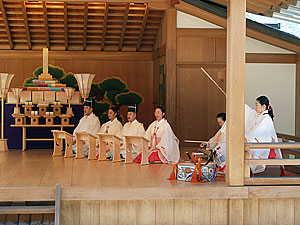The Japanese Arts beyond National Boundaries
by Neil Ryan Walsh
Neil Ryan Walsh gave the following speech at Oomoto’s Nagoya branch on Feb. 17th, 2008.
It is an honor to be here today. Thank you Mr. Hori for your introduction, and thanks to all of you for giving me this opportunity to attend your Tsukinamisai and to get to know you better. This is my fourth visit to Oomoto, but my first visit to one of the branches. So it is quite an honor to be invited to the Nagoya branch.
I was greatly impressed by today’s service. This is my first time to start a service with the practice of chinkon meditation. Mr. Yano informed me that this is not a common practice before the tsukinamisai, but something that is unique to Nagoya. I found that the chinkon helped to settle my mind to be more ready for prayer.
While watching the service I felt a sense of appreciation for food in the precise movements of the priests in addition to the sense of abundance in God’s bounty. I could understand some parts of Mr. Hori’s speech and considered his comments about the importance of paying special attention to the food we eat, particularly in the wake of the current Gyoza scandal. I could also understand a little from the spiritual leader’s address advising followers to be careful and thoughtful in all of their daily activities.
I decided that I would make a new commitment in my life to appreciate the food that I eat and prepare. I believe that it is important not only to participate in a religious or spiritual practice but to take a message from the practice and put it into action. Thank you for this immense learning opportunity.
I come from New York City, and I have lived in Japan since August 2006. This is my second time living in Japan. I was here as a student in 2002.
I teach English in Tokyo, and I am also starting a project called Japan for Equal Dignity. This project aims to study Japanese culture through the lens of dignity, looking at which practices and cultural institutions “walk the talk” of peace and equal dignity for all, and how those examples of dignity in Japan can be adopted to create a more dignified world.
I would like to tell you how my relationship with Oomoto has become one of my most significant experiences, not only in Japan but in my entire life. I first learned of Oomoto more than a year ago. Let me tell you how it happened.
I was teaching English to middle school students in Tochigi and they were having many problems learning English. I was familiar with claims that Esperanto is much easier to learn then other languages, and that learning Esperanto can help people to acquire other languages more quickly.
So I did an Internet search to learn more about Esperanto. One of the articles I found mentioned Oomoto and how it practices and promotes Esperanto. I have not studied Esperanto up until now but do plan to study it in the future.
I said to myself, “I would really like to visit that religion the next time I go to Kyoto.” Little did I realize how connected this religion is with the original source and that my desire to “visit” Oomoto would be my destiny.
A few weeks after seeing that article on the Internet, I met Hiromi Yano and Bill Roberts at the 2006 Hiroshima International Peace Summit.
Bill began telling me about Oomoto. I thought I had never heard of this group, and I was very interested. But then it dawned on me that this may have been the group I had read about on the Internet that was famous for speaking and promoting Esperanto. And indeed it was the same group.
Bill and I kept in close contact after that meeting and when he was at Oomoto last March we arranged to meet in Kameoka for the Tsukinamisai.
In all, I made three trips to Oomoto last year. The first trip was the one I just mentioned when I attended the monthly service. After the service, I was impressed to see the children performing the monthly tea ceremony.
That day I also talked with Mr. Yano about my interest in Noh theatre. He invited me for the Miroku Noh festival in May, and also invited me back in August, when I joined the Oomoto group to attend the World Religious Summit on Mt. Hiei. I was very impressed.
Each of these visits expanded my understanding of Oomoto and its mission.
On this, my fourth visit, I am staying at the Kameoka headquarters international department for a month as a volunteer helping develop the Oomoto’s English website, helping young Oomoto staffers with their English, and assisting the international department in any way I can. I would like to share with you my impressions of Oomoto so far.
On that first visit to Kameoka a year ago, Bill gave me a tour of the grounds, including a stop at the small museum to see Onisaburo Deguchi’s yowan. There were three on display that day.
I was stunned, absolutely stunned, by them. I can still think of no words to describe them. In some ways they looked like they were made with a child’s heart and mind; created with a sense of wonder, freshness, awe and challenge.
I believe that Onisaburo Deguchi’s art is a message, a gift, a living lesson. His art is a mysterious teaching about the unerring state of human wonder.
His art and the art of all of the spiritual leaders are examples of how to live a dignified life in the present world. The entire collection of his yowan is a masterpiece, a bible if you will of absolute truth, waiting for a receptive audience.
I believe the following quote from In Search of Meaning by the great Oomoto teacher Hidemaru Deguchi expresses Onisaburo’s enlightenment as I saw it in his youwan, “According to the old saying, a great sage is often taken for a great fool and the enlightened man is like a child.” As an aside, I have been reading this book for the past few days and think that it is a great spiritual masterpiece. I would like to see it be made more widely available to an international audience.
My second trip to Oomoto was for the Miroku Noh festival last year. I have been interested in Noh theatre since I studied in Japan during 2001-2002. I met an American in Tokyo who taught Noh theatre, and was able to see several performances.
I had been a fan of Western-style opera for many years before I came to Japan. A Noh performance is simple compared to a full opera, but I found Noh to be much more powerful than anything I had experienced in the many operas I had seen at Lincoln Center in New York.
I remember going back to New York in 2002 and attending a performance of “Carmen” at the Metropolitan Opera House. As the opera started I thought that this spectacular performance did not have nearly as much power as the beginning of a Noh.
I intuitively understood that Noh is a performance not for man’s pleasure but for God. I am always impressed by the fact that the Noh actors never come out at the end of a performance and take bows as is common on the Western stage, and the audience neither claps nor applauds during the performance.
But I was disappointed whenever I tried to talk with young Japanese about Noh theatre and many other aspect of Japanese art and culture. I would often get a response like this: “We young Japanese don’t care about that anymore,” or “maybe my grandmother is interested in that.”
I did not want to believe these opinions. I wanted to believe that there are young Japanese people who are interested in Japanese traditional culture. So of course I was thrilled when I learned that Oomoto followers, young and old, are deeply interested in traditional Japanese culture.
What I witnessed at the Miroku Noh at Oomoto was breathtaking, seeing middle school students perform and retired person’s alike performing Noh.
At one point in the morning a woman was performing a Noh with a Buddhist theme. All of a sudden a group of Oomoto priests walked into the Banshoden, approached the main alter and performed a small service.
A feeling of wonder came over me when I heard the Oomoto Norito being chanted and the Noh being performed at the same time. It was as if both were being done for God and we in the audience had the great privilege to observe from the sidelines.
My third experience with Oomoto was at last year’s World Prayer for Peace Day at Mt. Hiei where I first learned the phrase Bankyo-Dokon. I am truly grateful for the opportunity to participate in that historical event.
As I understand it, the event is held every year, but last year was special because it was the 20th anniversary. A new bell for world peace was cast and hung at Mt. Hiei for the event. The first people to ring it were a group of six youths from Boznia and Hertzogovenia and six young Oomoto followers from Hiroshima.
I was very aware of the prominent position of Oomoto’s Spiritual Leader at this event. Madame Kurenai Deguchi was always standing or sitting next to the Tendai zasu Koujun Handa. I was deeply impressed that she was the only female on the stage of world religious leaders.
I hope that Oomoto’s example of interreligious work will spread around the world. While Oomoto’s continued commitment to interreligious understanding is important, what is more fundamental is that Oomoto is one of the few religions in the world that has a language and spiritual tradition appropriate for interreligious activity.
One point I would like to convey is that many westerners, myself included, are interested in Japanese culture and the Japanese arts: Noh, the tea ceremony, and Shinto just to name a few.
I believe many Japanese feel removed from the world of the Japanese arts. I suspect the reasons for this are partly historical, the exclusivity associated with practicing the arts, and the hierarchical structures in the schools.
I am deeply impressed that Oomoto promotes the traditional Japanese arts, encourages followers to study them, and provides members and non-members the chance to experience the arts – often for the first time.
I would like to end on this point: While these arts were born in Japan, and have a unique Japanese style, they are not meant for Japan alone. The Japanese arts extend beyond national boundaries and transcend spiritual borders.
Oomoto has become an important venue for me to learn more about traditional Japanese culture. As an American, I am looking at ways your traditional arts and culture might contribute to making a more peaceful and dignified world.
Thank You.
Dankon.
Domo Arigatou Gozaimashita.
Mr. Yoshio Hori is the Nagoya branch chief. The branch chief addresses the congregation immediately following the monthly service. My speech followed Mr. Hori’s address.
Gyoza, Chinese dumplings, are immensely popular in Japan.
Brightly colored tea bowls, made by Oomoto co-founder Deguchi Onisaburo during a intensely creative period late in his life.
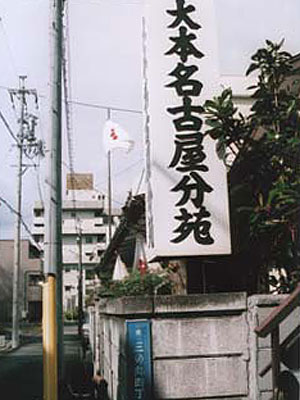
Nagoya chapter is located on a residental side street in downtown Nagoya.
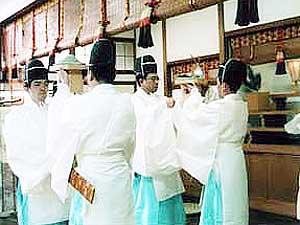
Nagoya priests offering products from local harvest to the main alter.
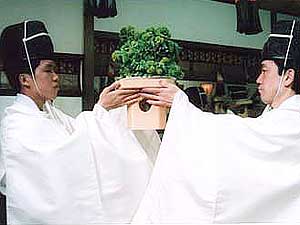
A offering of rape blossoms.
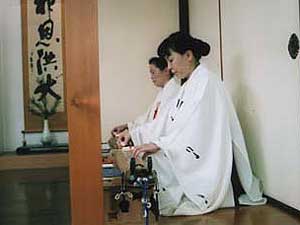
A Koto melody creates an atmosphere for the ceremonial offerings.
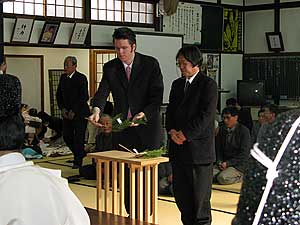
Neil Walsh and Hiromi Yano offering Tamagushi.
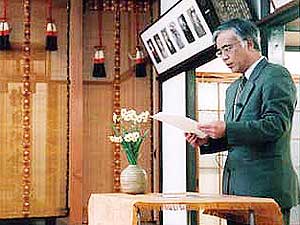
Chapter chief Yoshio Hori addresses the congregation.
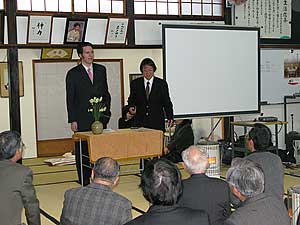
Neil Walsh giving speech to the crowd.
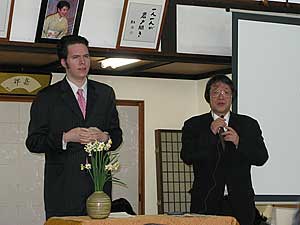
Hiromi Yano busy translating.
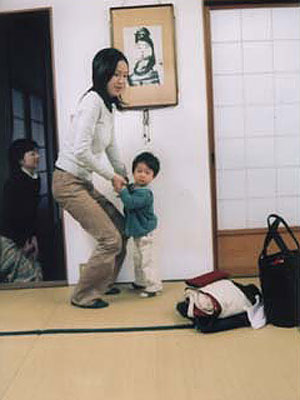
A captive audience member hangs onto every word.
New Contents Thu, May 20, 2010
- Oomoto participates in Sant’Egidio conference : Dialogue among religions and cultures : On divided island nation of Cyprus By Bill Roberts
- Photo Album : Portraits of three branches: Shoko, Tanegashima and Aomori By Bill Roberts
- Oomoto FAQ
- A Letter from Oomoto : Of mountains and myths By Bill Roberts
- Polyglot poem festival The Utamasturi is going international — what’s next? By Bill Roberts
- Ethics education program captures the spirit of Bankyo Dokon By Bill Roberts
- A Letter from Oomoto : A year’s worth of adventure in a summer of branch visits By Bill Roberts
- In Kumamoto, it’s all about water – and fire By Bill Roberts
- A speech by Nevada Taylor at the Kii Branch in Wakayama Prefecture on April 13, 2008.:An Encounter With Oomoto Through Aikido
- Utamatsuri, Poem Festival, in Tokyo(on April 17, 2008)
- A speech by Neil Ryan Walsh at the Kobe branch on Mar. 9th, 2008.:Planting the Seeds of the Soul
- Meeting with the Fifth Spiritual Leader of Oomoto, Madame Kurenai Deguchi by Neil Ryan Walsh
- A speech by Neil Ryan Walsh at the Nagoya branch on Feb. 17th, 2008.:The Japanese Arts beyond National Boundaries
- To the Oomoto branch in Nagoya: City of Eel and Toyota by Neil Ryan Walsh
- A Speech by Nissim Ben Shitrit, Ambassador of Israel on the occasion of the Oomoto Setsubun Grand Festival in Ayabe February 3rd, 2008 : Japan and Israel : Two Lands Balancing the Needs of Traditional Culture and Modern Life. r
- A permanent memorial to Onisaburo (A Speech at the Autumn Grand Festival , November 6, 2007 : )By James Parks Morton, Founder and Chair, Emeritus of The Interfaith Center of New York
- Israel, Palestine and the Power of Poetry(Oomoto believes small efforts can have lasting ripple effects on people and peace)By Bill Roberts
- “Something Great”(This genetics pioneer, a friend of Oomoto, offers a clue to the mystery of life)By Bill Roberts
- Kamishima Cleanup (Harima branch members regularly visit this sacred island to keep the shrine tidy)By Bill Roberts
- Kyotaro Deguchi was one of six recipients of the 2007 James Parks Morton Interfaith Award
What is Oomoto?
- What is Oomoto?
- Spirtual Centers
- Founders and Spiritual Leaders
- History
- Organization and activities
- Teachings and scriptures
- Art Works of Founders and Leaders
Opinions[Archive]
- Statement of regret for the outbreak of war against Iraq (March 20,2003)
- Jinrui Aizenkai dispatched the "Urgent Appeal for a World (Global) Crisis" on March 14.
Grappling with Bioethics[Archive]
- Oomoto’s support for abolishing the death penalty (12, June 2003)
- The Oomoto Foundation protests any birth of a human clone baby. (5, January 2003)
- OOMOTO'S VIEW REGARDING JAPAN’S PERMITION TO THE RESERCH OF HUMAN EMBRYONIC STEM CELLS (ES cells)(12, June 2000)
Vistor’s Review[Archive]
- A speech by Bill Roberts at the Oomoto branch in Hiroshima after its monthly service on March 18, 2007:Encounters with war and peace
- How Bankyo Dokon changed one life by Linda Macphee
- A speech by Bill Roberts at the Hokuriku (Kanazawa) branch on Dec. 3, 2006:Ritual and myth -an encounter with ‘divine madness’
- A speech by Bill Roberts at the Himeji Cultural Center on Feb. 25, 2007:Mesmerized by the Japanese Arts
- A speech by Bill Roberts at the Kobe branch on Feb. 11th, 2007.:There are just human tears and human joy
- A Speech on the occasion of the Oomoto Setsubun Grand Festival in Ayabe February 3rd, 2007 : Egypt's role in Middle East peace
- Keynote Speech for the 28th World Federation Japanese Religionists Conference for World Peace in Tokyo (at Kokugakuin University, Novermber 29, 2006):Vision for Peace in the Middle East By Dr. Munther S. Dajani, Professor Dean, Faculty of Arts, Al Quds University, Jerusalem
- A speech to the Kyoto branch:Spiritual adventures in researching Oomoto leaders
- A Speech at The Oomoto Foundation on Monday, November 6, 2006 : Jordan's role in Middle East By Samir Nouri, Ambassador of the Hashemite Kingdom of Jordan
- A letter from Oomoto:The Young People of Tottori
- A speech by Bill Roberts on the occasion of the dedication ceremony for the new shrine of Tottori Branch By Bill Roberts Oct. 8, 2006
- A speech by Bill Roberts at the Oomoto branch in Hiroshima after its monthly service on March 18, 2007:Encounters with war and peace
- How Bankyo Dokon changed one life by Linda Macphee
- A speech at Setsubun : A Portrait of Oomoto By Bill Roberts Feb. 3, 2006
- New Publication ! By Bill Roberts Feb. 3, 2006 A Portrait of Oomoto
you can read this book in html => http://www.jinruiaizenkai.jp/English/en-kolumno/en-bill/en-sugao/billbook1en.html
E-mail below to order brobert1@ix.netcom.com
Current Topics
- Prayer Offering and World Religious Forum II
- Living the art of dialogue
- Kyotaro Deguchi was one of six recipients of the 2007 James Parks Morton Interfaith Award
Books
Online Books
- Divine Signposts by Onisaburo DEGUCHI
- The Creation of Meaning by Hidemaru Deguchi
- Bankyo Dokon(Seventy years of Inter-Religious Activity at Oomoto)
- Nao Deguchi — A Biography of the Foundress of Oomoto
- The Great Onisaburo Deguchi published by Aiki News
- Bankyo Dokon Seventy Years of Inter-Religious Activity at Oomoto
- Insearch of Meaning
- Nao Deguchi A Biography of the Foundress of Oomoto
- A Portrait of Oomoto By Bill Roberts
Oomoto international Archive
- The History of Oomoto (Jan.– Mar. 1980 — Apr.– Jun. 1982)
- The Ancestors; Friends or Foes? (Apr.– Jun. 1987)
- Tsukinamisai; The Sabbath of Shinto (Jan.– Jun. 1983)
- The Poem Festival at Oomoto; An Ancient Rite Lives Again (Oct.– Dec. 1981)
- Purification of the Universe ; Oomoto's Setsubun Festival (Apr.– Jun. 1981)
Links
Flowers at Ten'on-kyo & Baisho-en (photographs)
Contact
All rights reserved : the Oomoto Foundation Produced by the Netinformational Commission
Since : Mar. 7.1998 Last Update : Thu, May 20, 2010
E-mail : webmaster@oomoto.or.jp
Top Page Nihongo Esperanto Português Roomazi



